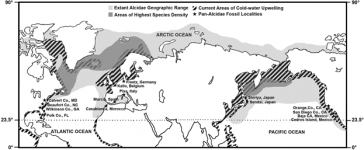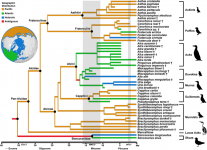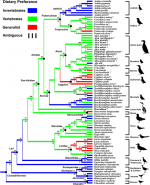Graham, B.A., J.M. Hipfner, N.A. Rojek, S.W. Stephensen, and T.M. Burg (2023)
Tufted Puffins exhibit low levels of genetic differentiation among breeding colonies in North America
Ornithological Applications (advance online publication)
doi: 10.1093/ornithapp/duad023
Tufted Puffins (
Fratercula cirrhata) are experiencing population declines in some parts of their distribution, making this a species of increased conservation interest. Genetic data will help to identify Tufted Puffin populations of conservation importance and provide an important tool for developing conservation management plans. This species is broadly distributed across the North Pacific Ocean, but little is known about the extent of genetic variation and differentiation across their range. In this study we examine mitochondrial DNA (mtDNA), 8 microsatellite loci and 1,260 single nucleotide polymorphisms (SNPs) to determine the extent of gene flow among 7 breeding colonies (Oregon to the western Aleutians) in the North American breeding range of the species and identify potential barriers to dispersal. Our results show that most breeding colonies form a single genetic cluster, and mtDNA data show substantial historical gene flow among populations. For the microsatellite dataset, all
FST comparisons that include St. Lazaria, in southeast Alaska, except Oregon, which had a small sample size, were significant as were comparisons between Triangle Island and the two westernmost sampling sites of Buldir and Aiktak. For the SNP dataset,
FST comparisons were low and nonsignificant, further suggesting that breeding colonies form a single panmictic population. Individuals were more closely related to individuals from the same colony, and we found a weak relationship between genetic and geographic distance. This suggests that dispersal among colonies is high, likely facilitated by overlap in wintering ranges among colonies. The high connectivity among breeding colonies indicates that Tufted Puffins form a single conservation unit, although future genetic studies should incorporate a whole genome sequencing approach to assess how functional genetic diversity varies across their distribution.








